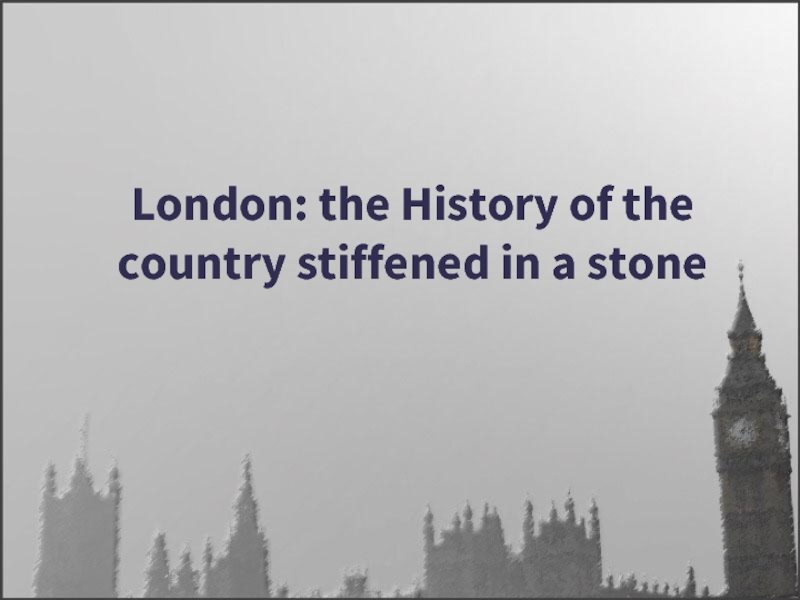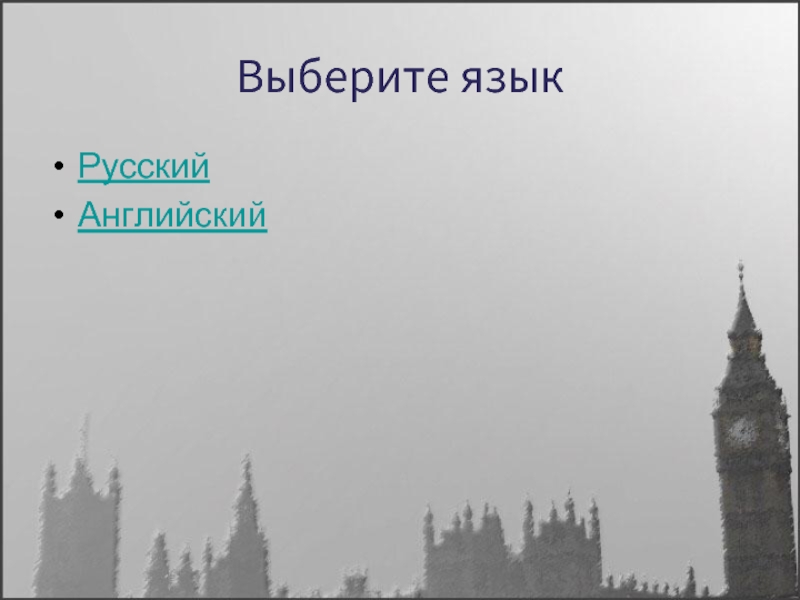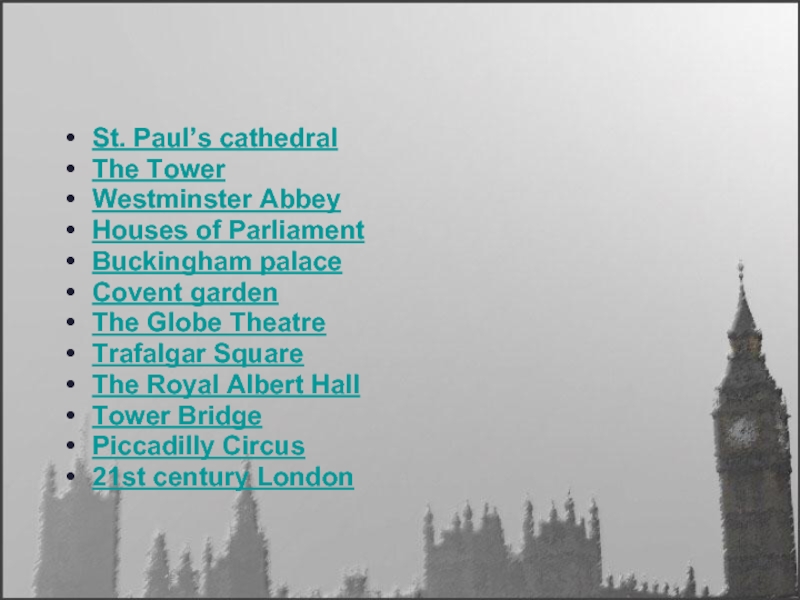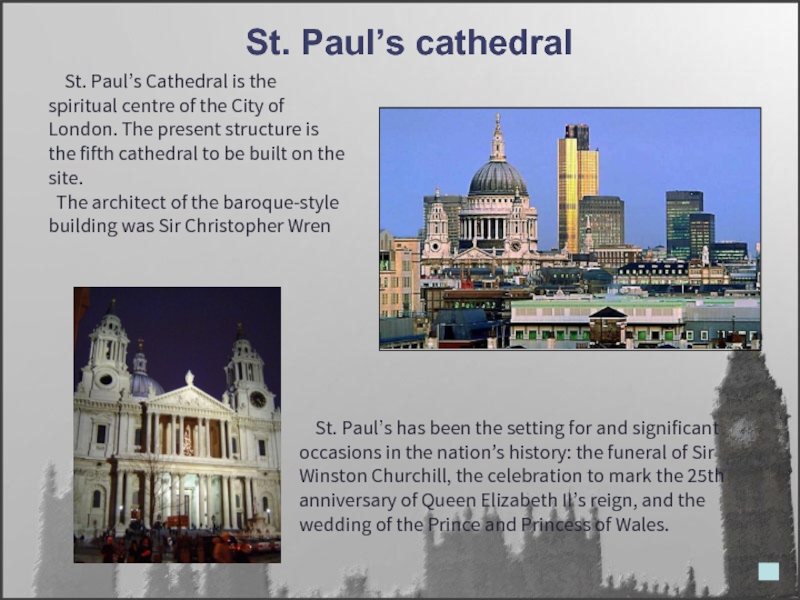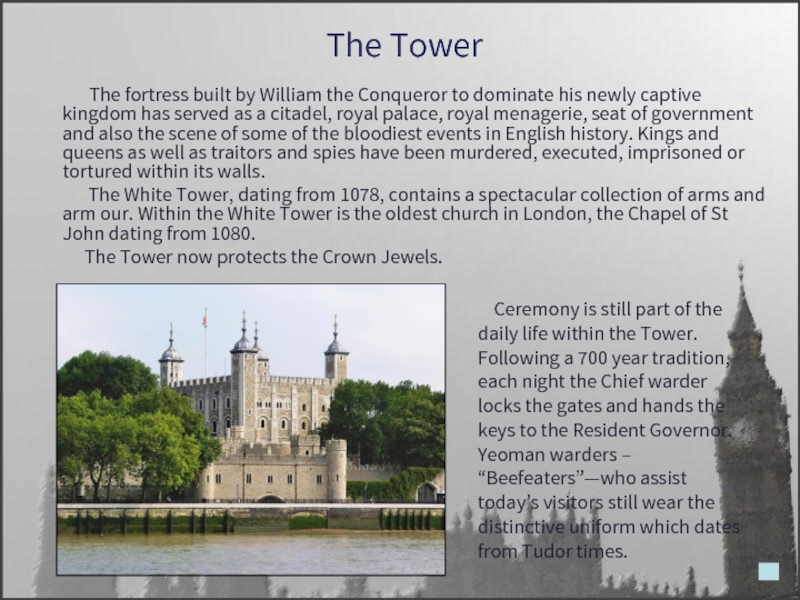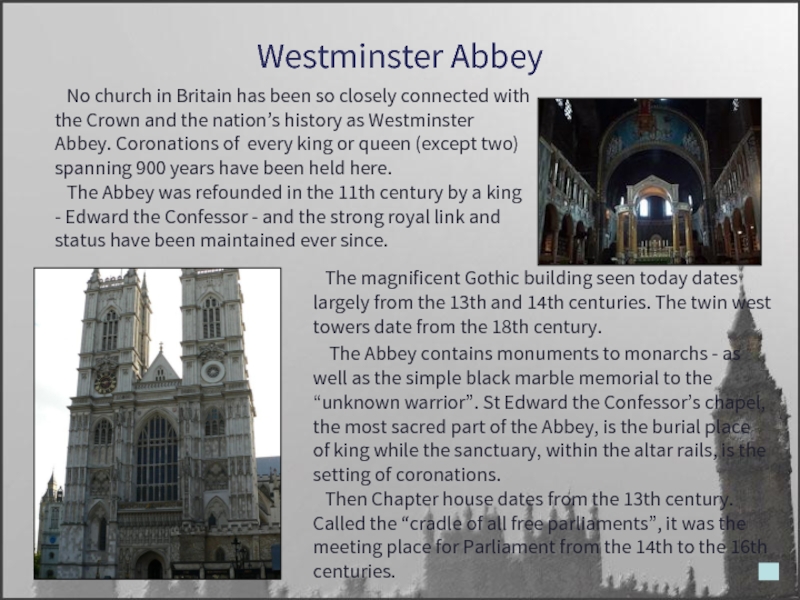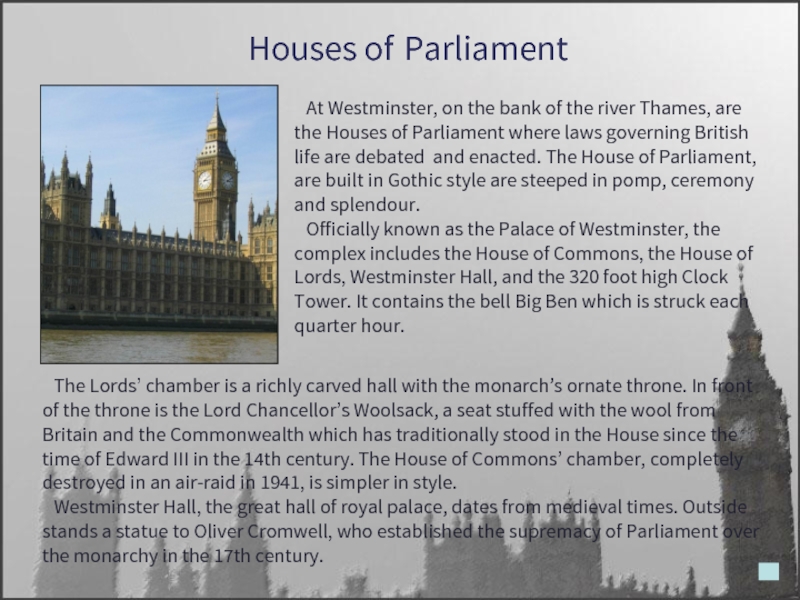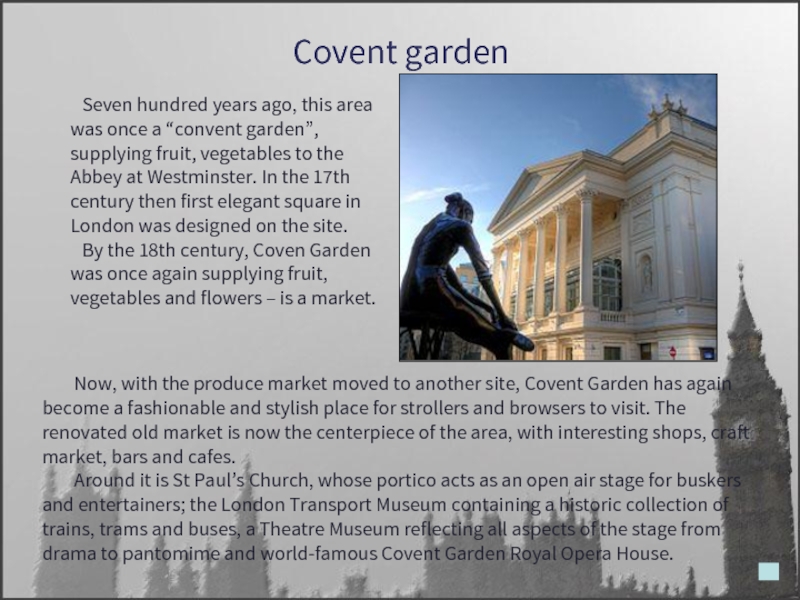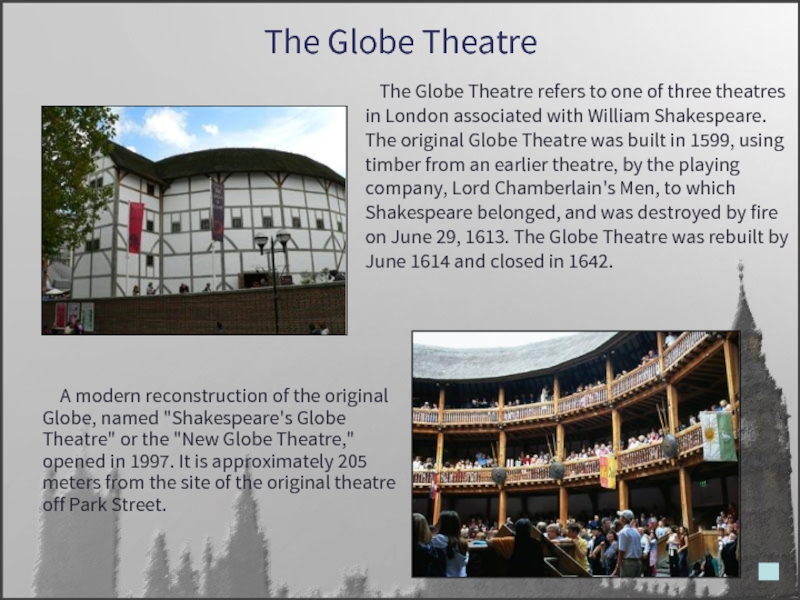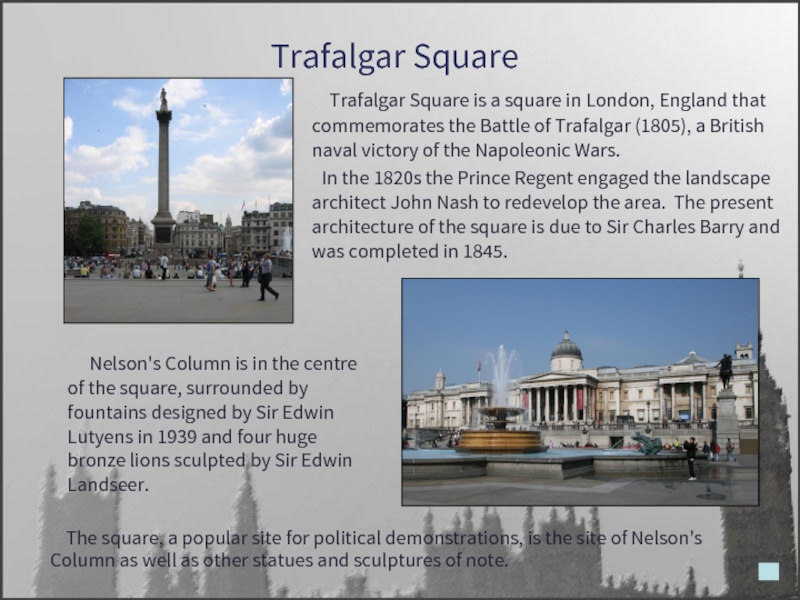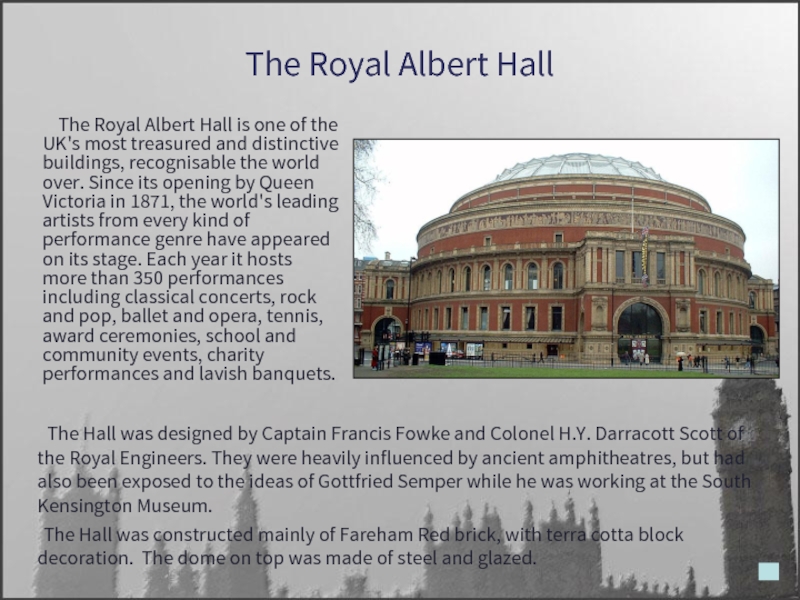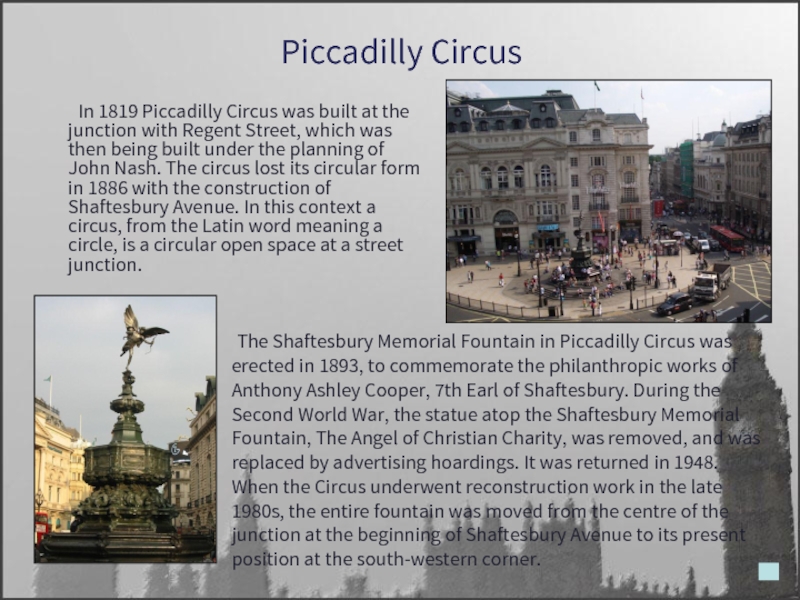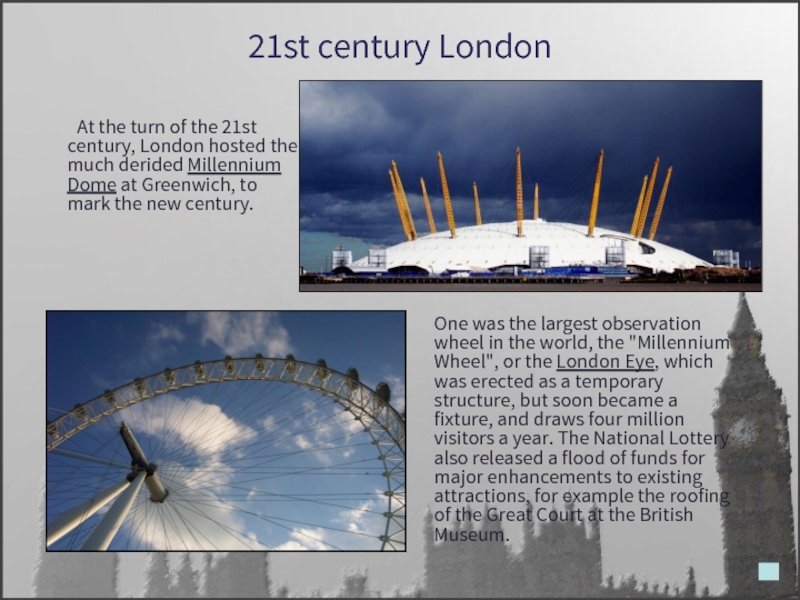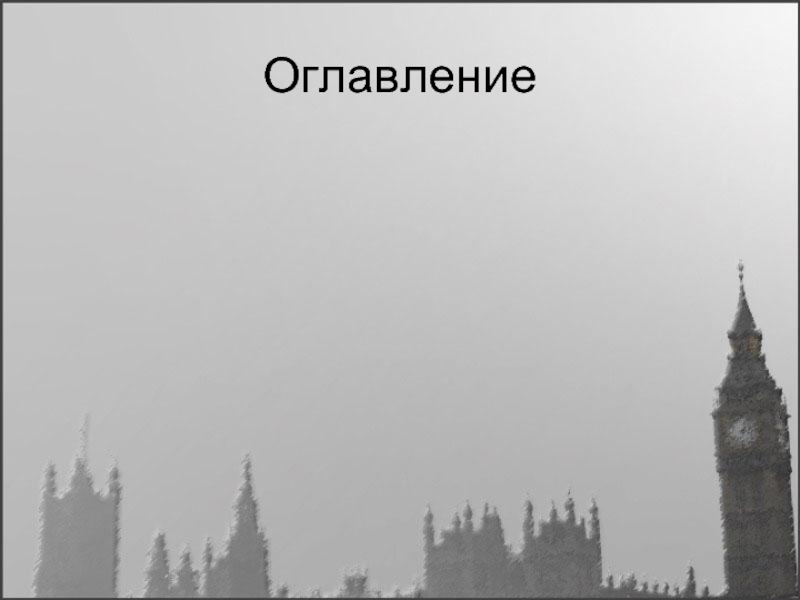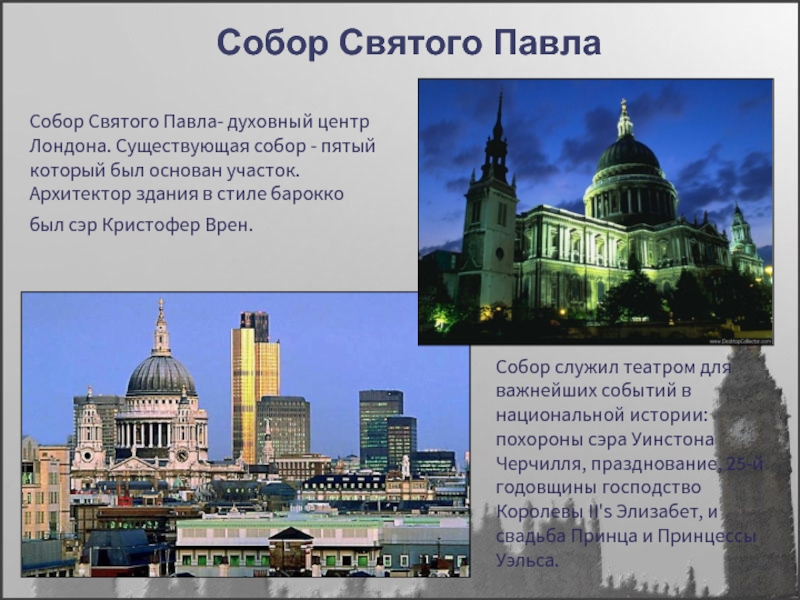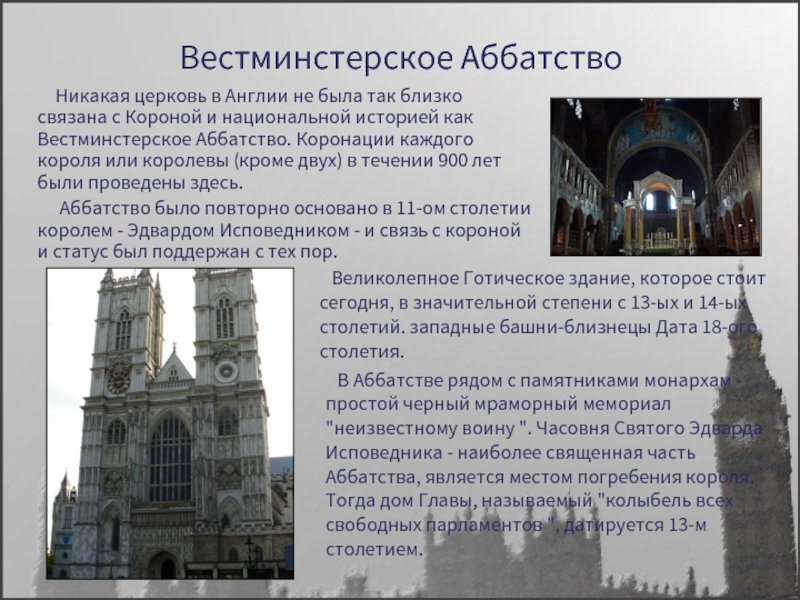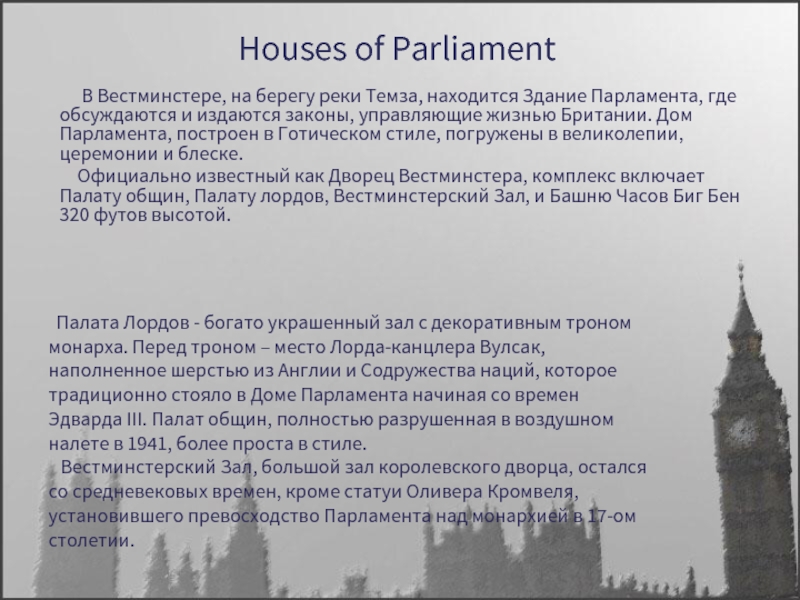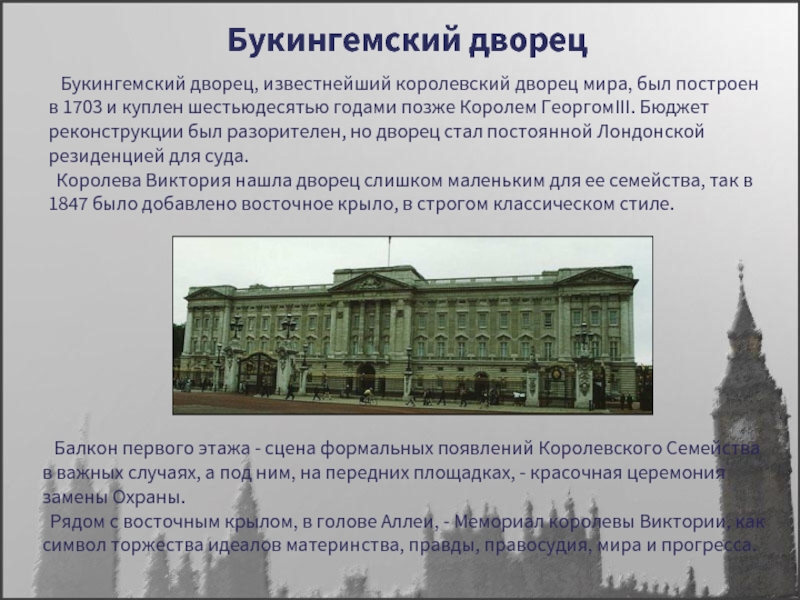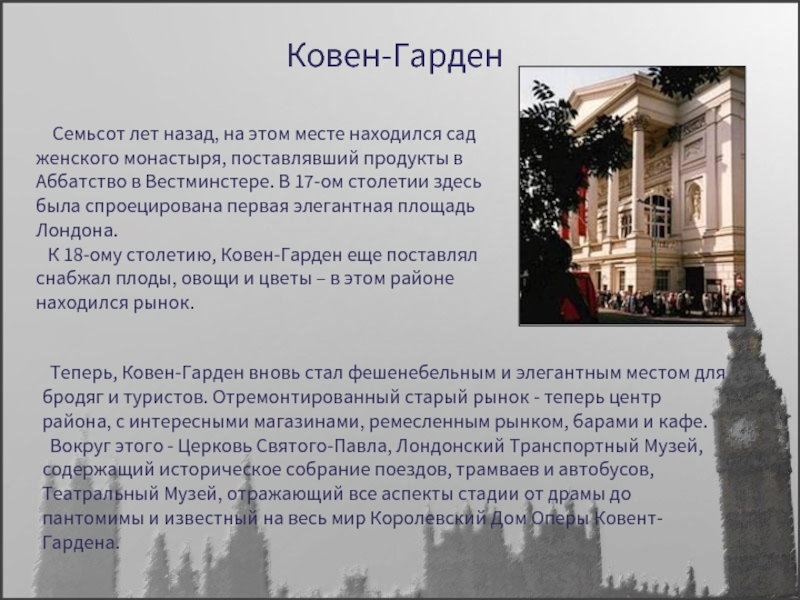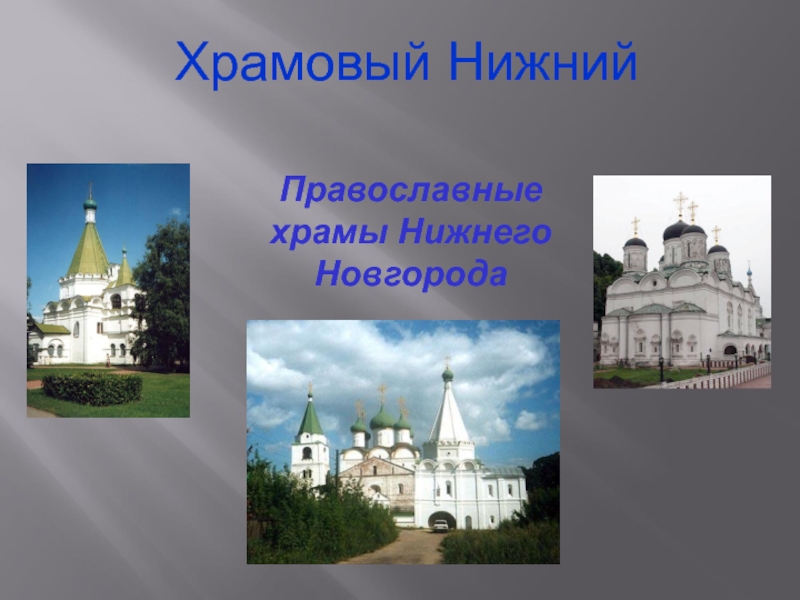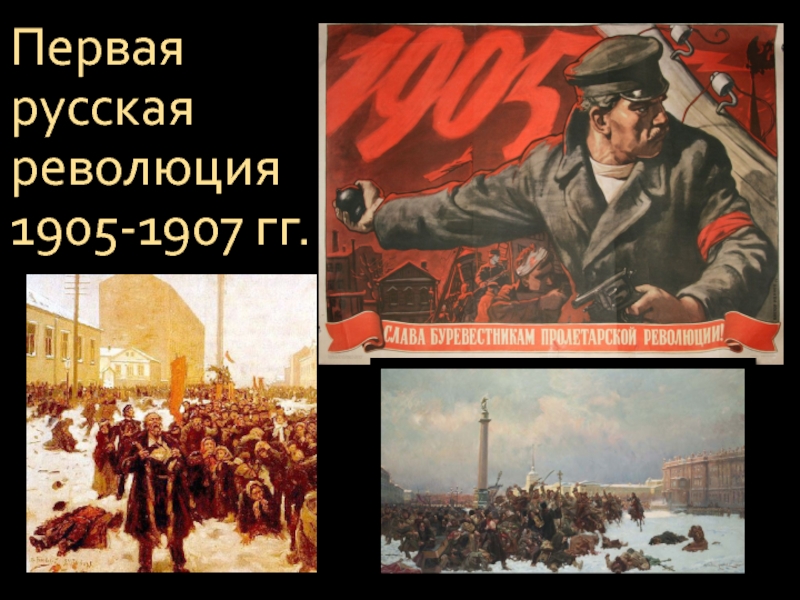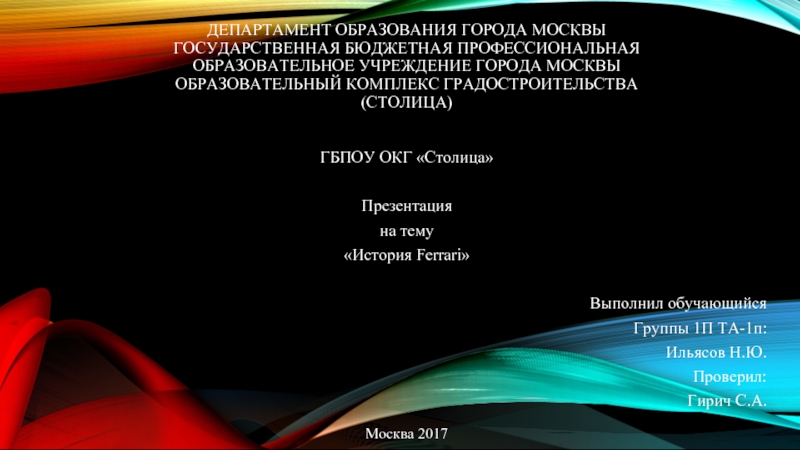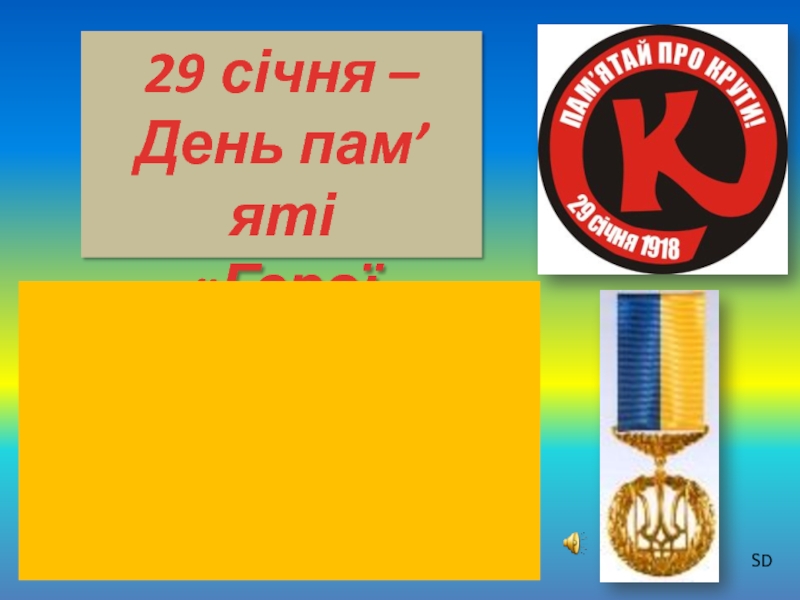- Главная
- Разное
- Дизайн
- Бизнес и предпринимательство
- Аналитика
- Образование
- Развлечения
- Красота и здоровье
- Финансы
- Государство
- Путешествия
- Спорт
- Недвижимость
- Армия
- Графика
- Культурология
- Еда и кулинария
- Лингвистика
- Английский язык
- Астрономия
- Алгебра
- Биология
- География
- Детские презентации
- Информатика
- История
- Литература
- Маркетинг
- Математика
- Медицина
- Менеджмент
- Музыка
- МХК
- Немецкий язык
- ОБЖ
- Обществознание
- Окружающий мир
- Педагогика
- Русский язык
- Технология
- Физика
- Философия
- Химия
- Шаблоны, картинки для презентаций
- Экология
- Экономика
- Юриспруденция
London: the History of the country stiffened in a stone презентация
Содержание
- 1. London: the History of the country stiffened in a stone
- 2. Выберите язык Русский Английский
- 3. St. Paul’s cathedral The Tower Westminster Abbey
- 4. St. Paul’s Cathedral is the
- 5. The Tower The fortress
- 6. Westminster Abbey No church in
- 7. Houses of Parliament At Westminster,
- 8. Buckingham palace The first
- 9. Covent garden
- 10. The Globe Theatre
- 11. Trafalgar Square
- 12. The Royal Albert Hall
- 13. Tower Bridge
- 14. Piccadilly Circus
- 15. 21st century London
- 16. Оглавление
- 17. Собор Святого Павла- духовный центр Лондона.
- 18. Тауэр Крепость, построенная Вильгельмом Завоевателем, чтобы доминировать
- 19. Вестминстерское Аббатство Никакая церковь в Англии
- 20. В Вестминстере, на берегу реки
- 21. Букингемский дворец Балкон первого этажа
- 22. Ковен-Гарден Теперь, Ковен-Гарден вновь стал фешенебельным
Слайд 3St. Paul’s cathedral
The Tower
Westminster Abbey
Houses of Parliament
Buckingham palace
Covent garden
The Globe Theatre
Trafalgar
The Royal Albert Hall
Tower Bridge
Piccadilly Circus
21st century London
Слайд 4 St. Paul’s Cathedral is the spiritual centre of the
St. Paul’s has been the setting for and significant occasions in the nation’s history: the funeral of Sir Winston Churchill, the celebration to mark the 25th anniversary of Queen Elizabeth II’s reign, and the wedding of the Prince and Princess of Wales.
St. Paul’s cathedral
Слайд 5 The Tower
The fortress built by William the Conqueror
The White Tower, dating from 1078, contains a spectacular collection of arms and arm our. Within the White Tower is the oldest church in London, the Chapel of St John dating from 1080.
The Tower now protects the Crown Jewels.
Ceremony is still part of the daily life within the Tower. Following a 700 year tradition, each night the Chief warder locks the gates and hands the keys to the Resident Governor. Yeoman warders – “Beefeaters”—who assist today’s visitors still wear the distinctive uniform which dates from Tudor times.
Слайд 6Westminster Abbey
No church in Britain has been so closely
The Abbey was refounded in the 11th century by a king - Edward the Confessor - and the strong royal link and status have been maintained ever since.
The Abbey contains monuments to monarchs - as well as the simple black marble memorial to the “unknown warrior”. St Edward the Confessor’s chapel, the most sacred part of the Abbey, is the burial place of king while the sanctuary, within the altar rails, is the setting of coronations.
Then Chapter house dates from the 13th century. Called the “cradle of all free parliaments”, it was the meeting place for Parliament from the 14th to the 16th centuries.
The magnificent Gothic building seen today dates largely from the 13th and 14th centuries. The twin west towers date from the 18th century.
Слайд 7Houses of Parliament
At Westminster, on the bank of the
Officially known as the Palace of Westminster, the complex includes the House of Commons, the House of Lords, Westminster Hall, and the 320 foot high Clock Tower. It contains the bell Big Ben which is struck each quarter hour.
The Lords’ chamber is a richly carved hall with the monarch’s ornate throne. In front of the throne is the Lord Chancellor’s Woolsack, a seat stuffed with the wool from Britain and the Commonwealth which has traditionally stood in the House since the time of Edward III in the 14th century. The House of Commons’ chamber, completely destroyed in an air-raid in 1941, is simpler in style.
Westminster Hall, the great hall of royal palace, dates from medieval times. Outside stands a statue to Oliver Cromwell, who established the supremacy of Parliament over the monarchy in the 17th century.
Слайд 8Buckingham palace
The first floor balcony is the scene of
Facing the east front, at the head of the Mall, is the Queen Victoria Memorial. The statue of the seated monarch represents a celebration of the ideals of motherhood, truth, justice, peace and progress.
Buckingham palace, the best known royal palace in the world, was built in 1703 and bought sixty years later by King George III. The rebuilding budget was wildly overspent, but the palace became the permanent London base for the court. Queen Victoria found the palace too small for her growing family so an east wing was added in 1847. This was remodeled in 1913 to the present stern but dignified classical style.
Слайд 9Covent garden
Now, with the produce market moved
Around it is St Paul’s Church, whose portico acts as an open air stage for buskers and entertainers; the London Transport Museum containing a historic collection of trains, trams and buses, a Theatre Museum reflecting all aspects of the stage from drama to pantomime and world-famous Covent Garden Royal Opera House.
Seven hundred years ago, this area was once a “convent garden”, supplying fruit, vegetables to the Abbey at Westminster. In the 17th century then first elegant square in London was designed on the site.
By the 18th century, Coven Garden was once again supplying fruit, vegetables and flowers – is a market.
Слайд 10The Globe Theatre
The Globe Theatre
A modern reconstruction of the original Globe, named "Shakespeare's Globe Theatre" or the "New Globe Theatre," opened in 1997. It is approximately 205 meters from the site of the original theatre off Park Street.
Слайд 11Trafalgar Square
Trafalgar Square is a
In the 1820s the Prince Regent engaged the landscape architect John Nash to redevelop the area. The present architecture of the square is due to Sir Charles Barry and was completed in 1845.
Nelson's Column is in the centre of the square, surrounded by fountains designed by Sir Edwin Lutyens in 1939 and four huge bronze lions sculpted by Sir Edwin Landseer.
The square, a popular site for political demonstrations, is the site of Nelson's Column as well as other statues and sculptures of note.
Слайд 12The Royal Albert Hall
The Hall
The Hall was constructed mainly of Fareham Red brick, with terra cotta block decoration. The dome on top was made of steel and glazed.
The Royal Albert Hall is one of the UK's most treasured and distinctive buildings, recognisable the world over. Since its opening by Queen Victoria in 1871, the world's leading artists from every kind of performance genre have appeared on its stage. Each year it hosts more than 350 performances including classical concerts, rock and pop, ballet and opera, tennis, award ceremonies, school and community events, charity performances and lavish banquets.
Слайд 13Tower Bridge
The bridge was
Tower Bridge is a combined bascule and suspension bridge over the River Thames. It is close to the Tower of London, which gives it its name.
Jones' engineer, Sir John Wolfe Barry devised the idea of a bascule bridge 800 feet in length with two towers each 213 feet (65 m) high, built on piers. The central span of 200 feet (61 m) between the towers was split into two equal bascules or leaves, which could be raised to an angle of 83 degrees to allow river traffic to pass.
The bascules, weighing over 1,000 tons each, were counterbalanced to minimize the force required and allow raising in five minutes.
Слайд 14Piccadilly Circus
In 1819 Piccadilly Circus was
The Shaftesbury Memorial Fountain in Piccadilly Circus was erected in 1893, to commemorate the philanthropic works of Anthony Ashley Cooper, 7th Earl of Shaftesbury. During the Second World War, the statue atop the Shaftesbury Memorial Fountain, The Angel of Christian Charity, was removed, and was replaced by advertising hoardings. It was returned in 1948. When the Circus underwent reconstruction work in the late 1980s, the entire fountain was moved from the centre of the junction at the beginning of Shaftesbury Avenue to its present position at the south-western corner.
Слайд 1521st century London
At the turn of
One was the largest observation wheel in the world, the "Millennium Wheel", or the London Eye, which was erected as a temporary structure, but soon became a fixture, and draws four million visitors a year. The National Lottery also released a flood of funds for major enhancements to existing attractions, for example the roofing of the Great Court at the British Museum.
Слайд 17 Собор Святого Павла- духовный центр Лондона. Существующая собор - пятый который
Собор служил театром для важнейших событий в национальной истории: похороны сэра Уинстона Черчилля, празднование, 25-й годовщины господство Королевы II's Элизабет, и свадьба Принца и Принцессы Уэльса.
Собор Святого Павла
Слайд 18Тауэр
Крепость, построенная Вильгельмом Завоевателем, чтобы доминировать над его недавно пленным королевством
Белая Башня, датируясь от 1078, содержит захватывающее собрание рук{*оружия*} и вооружать наш. В пределах Белой Башни - самая старая церковь в Лондоне, Часовня C-Джон, датирующийся от 1080.
Башня теперь защищает Драгоценные камни Короны.
Церемония - все еще часть ежедневной жизни в пределах Башни. После 700-летней традиции, каждую ночь Главный warder запирает ворота и вручает ключи Губернатору Резиденции. Yeoman warders - "Beefeaters" – те, кто помогают сегодняшним посетителям все еще носить отличительную униформу времен Тюдоров.
Слайд 19Вестминстерское Аббатство
Никакая церковь в Англии не была так близко связана
Аббатство было повторно основано в 11-ом столетии королем - Эдвардом Исповедником - и связь с короной и статус был поддержан с тех пор.
Великолепное Готическое здание, которое стоит сегодня, в значительной степени с 13-ых и 14-ых столетий. западные башни-близнецы Дата 18-ого столетия.
В Аббатстве рядом с памятниками монархам - простой черный мраморный мемориал
"неизвестному воину ". Часовня Святого Эдварда Исповедника - наиболее священная часть Аббатства, является местом погребения короля. Тогда дом Главы, называемый "колыбель всех свободных парламентов ", датируется 13-м столетием.
Слайд 20 В Вестминстере, на берегу реки Темза, находится Здание Парламента,
Официально известный как Дворец Вестминстера, комплекс включает Палату общин, Палату лордов, Вестминстерский Зал, и Башню Часов Биг Бен 320 футов высотой.
Houses of Parliament
Палата Лордов - богато украшенный зал с декоративным троном монарха. Перед троном – место Лорда-канцлера Вулсак, наполненное шерстью из Англии и Содружества наций, которое традиционно стояло в Доме Парламента начиная со времен Эдварда III. Палат общин, полностью разрушенная в воздушном налете в 1941, более проста в стиле.
Вестминстерский Зал, большой зал королевского дворца, остался со средневековых времен, кроме статуи Оливера Кромвеля, установившего превосходство Парламента над монархией в 17-ом столетии.
Слайд 21Букингемский дворец
Балкон первого этажа - сцена формальных появлений Королевского
Рядом с восточным крылом, в голове Аллеи, - Мемориал королевы Виктории, как символ торжества идеалов материнства, правды, правосудия, мира и прогресса.
Букингемский дворец, известнейший королевский дворец мира, был построен в 1703 и куплен шестьюдесятью годами позже Королем ГеоргомIII. Бюджет реконструкции был разорителен, но дворец стал постоянной Лондонской резиденцией для суда.
Королева Виктория нашла дворец слишком маленьким для ее семейства, так в 1847 было добавлено восточное крыло, в строгом классическом стиле.
Слайд 22Ковен-Гарден
Теперь, Ковен-Гарден вновь стал фешенебельным и элегантным местом для бродяг
Вокруг этого - Церковь Cвятого-Павла, Лондонский Транспортный Музей, содержащий историческое собрание поездов, трамваев и автобусов, Театральный Музей, отражающий все аспекты стадии от драмы до пантомимы и известный на весь мир Королевский Дом Оперы Ковент-Гардена.
Семьсот лет назад, на этом месте находился сад женского монастыря, поставлявший продукты в Аббатство в Вестминстере. В 17-ом столетии здесь была спроецирована первая элегантная площадь Лондона.
К 18-ому столетию, Ковен-Гарден еще поставлял снабжал плоды, овощи и цветы – в этом районе находился рынок.
